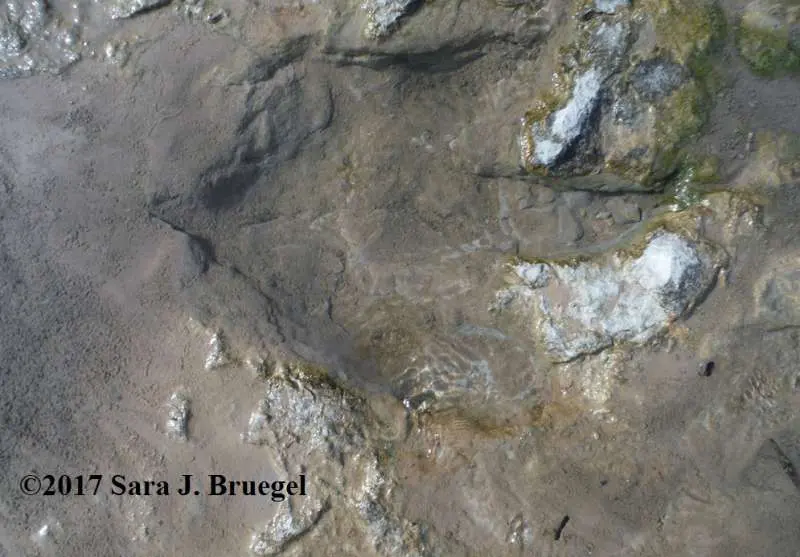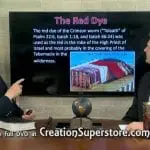The dark gray sky glowed with eerie shades of sickly green, rusty red, and deep purple. Patches of smoky black lingered low in the sky, sometimes broken by torrential shafts of rain. Deep rumbling noises and echoes of boiling water as it let off steam sounded constantly in the distance. Occasionally, those distant sounds were broken by sudden sharp noises of splintering wood, avalanching cliffs, explosions, and other noises.
Giant, brown waves swept back and forth across the land, carrying rocks of all sizes, shredded trees, and whatever else it picked up along the way. A retreating wave revealing the wet sandy beach. Moments later, the area shook, but not from an earthquake this time. The sooty air rang clear with distressed wails and dire groans of a stampede of strange creatures as they tried to run across the wet sand, leaving deep footprints.
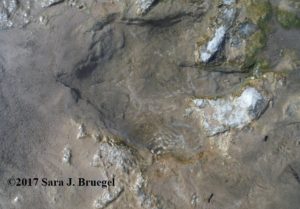
Another surge of water intruded the area before the animals could go very far, filling in their fresh footprints with new mud. They waded through the fast-rising waters until the water rose to their hips and started to sweep them off their feet. Struggling against the strong current the creatures frantically tried to paddle with their strong legs and short arms. Occasionally, they could feel the mud below touching their toes, then just the tips of their clawed toes touched the bottom. But, soon, these creatures were swept away by the waters and all the dry land was completely covered.
This is a picture of what it might have looked like when dinosaurs were trying to escape the rising waters of the world-wide flood, mentioned in the Bible in Genesis 6-9. Many paleontologists have trouble giving a good explanation for the different types of dinosaur footprint fossils because they believe that the earth is billions of years old and dinosaurs lived and died long before humans came on the scene, dismissing the idea of a global flood before it has even been seriously considered as a good model for explaining what we see. What I call “toe-print” fossils are good examples of a type of dinosaur footprint fossil better explained by models of the global flood than by the old earth models.
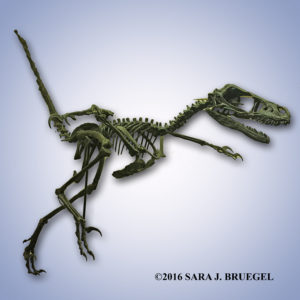 “Toe-print” fossils capture just the toes and claws of a two-legged dinosaur (like velociraptor or Iguanodon) touching wet sand. We have two options: either these dinosaurs were skilled ballerinas who danced along beaches and swamps, or their weight was being held up by water and they were moving their legs (trying to swim). “Toe-print” fossils like this have been found in several different places around the world. Some were discovered in China in 2013 and another site is in Australia.
“Toe-print” fossils capture just the toes and claws of a two-legged dinosaur (like velociraptor or Iguanodon) touching wet sand. We have two options: either these dinosaurs were skilled ballerinas who danced along beaches and swamps, or their weight was being held up by water and they were moving their legs (trying to swim). “Toe-print” fossils like this have been found in several different places around the world. Some were discovered in China in 2013 and another site is in Australia.
Lark Quarry Dinosaur Trackway in Queensland, Australia was first thought to be a stampede of small two-legged dinosaurs being hunted by a bigger dinosaur. By using computers to compare these tracks with other fossils, researchers recently discovered that they were actually made by all vegetarian dinosaurs (none trying to eat each other) and were originally mis-identified as the wrong type of dinosaur because they are “toe-print fossils”, not full footprints. Some of the marks left by dragging claws made them look like footprints belonging to another type of dinosaur.
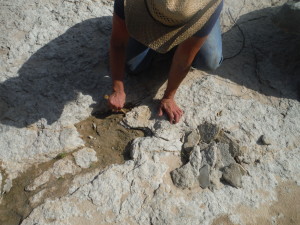
Some paleontologists say that these dinosaurs got caught in a small river flooding, just like rivers sometimes flood today. However, ripple patterns, dents made by dragging debris, and other markers in the rock indicate fast rising water and drastic changes happening within seconds, more severe than what we see today. If you zoom out, the rock layer containing Lark Quarry Dinosaur Trackway would require a “river” at least as wide as the Australian state of Queensland. That’s wider than the state of Texas. Putting that into perspective if you haven’t tried to drive across Texas, it would take over sixteen and a half hours of non-stop driving on a straight road at sixty miles per hour to go that distance. That would be a very wide river. Taking that in the context of the other fossils and rocks we see around the world, it seems best explained by a global, catastrophic flood.
Thinking about the global flood, it sounds very catastrophic and violent. Many creatures and people died in those flood waters. People often ask why God would horrifically destroy the earth and people He created and loved. But, perhaps there’s another question we should be asking: why has God been so very gracious and given people another chance over and over again?
This I recall to my mind, therefore have I hope. It is of the Lord’s mercies that we are not consumed, because his compassions fail not. They are new every morning: great is thy faithfulness. ~Lamentations 3:21-23
©2017 Sara J. Bruegel
References:
- University of Alberta. (2013, April 8). New evidence dinosaurs were strong swimmers. ScienceDaily. Retrieved January 12, 2017 from www.sciencedaily.com/releases/2013/04/130408123502.htm
- Oard, Michael J. A stampede of swimming dinosaurs. January 2014. Creation 36(1):38–41. Creation Ministries International. Retrieved January 12, 2017 from http://creation.com/dino-stampede
- Thomas, Brian, M.S. New Dinosaur Tracks Study Suggests Cataclysm. January 25, 2013. Institute for Creation Research. Retrieved Janurary 12, 2017 from http://www.icr.org/article/7249/265
- Clarey,Tim, Ph.D. Dinosaurs Swimming out of Necessity. April 26, 2013. Institute for Creation Research. Retrieved January 12, 2017 fromhttp://www.icr.org/article/dinosaurs-swimming-out-necessity

